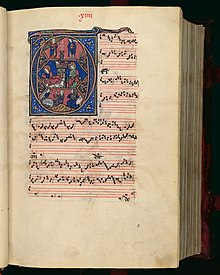Magnus Liber
 MS F | |
| Author | Anonymous |
|---|---|
| Country | France |
| Language | Latin |
| Subject | Musical score |
| Published | 13th century |
| Website | digitalcommons |
The Magnus Liber or Magnus liber organi (English translation: Great Book of Organum), written in
Surviving Manuscripts
The Magnus Liber organi most likely to have originated in Paris and is known today from only a few surviving manuscripts and fragments, and there are records of at least seventeen lost versions.[1] Today its contents can be inferred from the three surviving major manuscripts:
- Florence Manuscript [F] (I-Fl Pluteo 29.1, Biblioteca Medicea-Laurenziana, Florence ) 1,023 compositions | 1250 A.D.[3]
- Wolfenbüttel 677 [W1] (Wolfenbüttel Cod. Guelf. 628 Helmst.) Saint Andrews, Scotland | 1250 A.D.[3]
- Wolfenbüttel 1099 [W2] (Wolfenbüttel Cod. Guelf. 1099 Helmst.) French manuscript | after 1250 A.D.[3]
These three manuscripts date from later than the original Magnus Liber, but careful study has revealed many details regarding origin and development.[4] "Evidence of lost Notre Dame manuscripts, including the names of their owners, is plentiful indeed",[1] tracing back to year 1456 when manuscript F first appeared in the library of Piero de' Medici. Of the two others, referred to as W1 & W2, both in the Herzog August Bibliothek (Ducal Library), the first is thought to have originated in the cathedral priory of St Andrews, Scotland, and less is known about W2. Catalogues referring to other lost copies attest to the wide diffusion through Western Europe of the repertoire later called ars antiqua.
Heinrich Husmann summarizes that "these manuscripts, then, do not represent any more the original state of the Magnus Liber, but rather enlarged forms of it, differing from each other. In fact, these manuscripts embody different stylistic developments of the Magnus Liber itself, particularly in the field of composition mentioned by Anonymous IV, the clausula. This is born out by the differing versions of the discantus parts".[5] Husmann also notes that a comparison of the repertory contained in the three manuscripts shows there "are a great many pieces common to all three sources" and that "the most reasonable attitude is obviously to consider the pieces in common to all three sources as the original body, consequently as the true Magnus Liber organi".[5]
Contributors to the Liber
It is unknown whether the Magnus Liber had one sole contributor, though it is noted by scholars that large parts were composed by Léonin (1135–c.1200) and this conclusion is drawn from the writings of Anonymous IV.[3] Though it is a controversial topic among scholars, some believe parts of the Magnus Liber organi may have been revised by Pérotin (fl. 1200), while others such as Heinrich Husmann note that the finding is from 'the rather slim report of Anonymous IV' and that 'as for its connections with Notre Dame Cathedral in Paris, the name of Pérotin alone is adduced' in connection with his books having only been used. This 'by no means confirms that Pérotin himself was active at Notre Dame, or anywhere else in Paris for that matter'.[6]
The music from the Liber has been published in modern times by William Waite (1954),[7] Hans Tischler (1989),[8] and by Edward Roesner (1993–2009).[9]
Styles and Genres of the Repertoire

The
The Magnus Liber represents a step in the development of
The innovations at Notre Dame consisted of a system of
References
Further reading
- JSTOR 831000.

